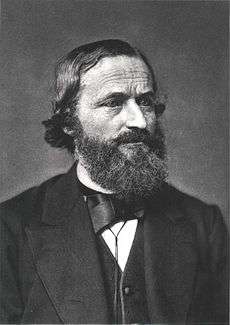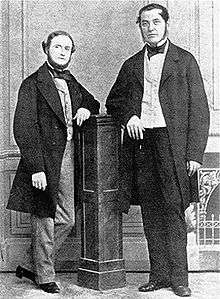Gustav Kirchhoff
Gustav Robert Kirchhoff (German: [ˈkɪʁçhɔf]; 12 March 1824 – 17 October 1887) was a German physicist who contributed to the fundamental understanding of electrical circuits, spectroscopy, and the emission of black-body radiation by heated objects.[1][2]
Gustav Kirchhoff | |
|---|---|
 Gustav Kirchhoff | |
| Born | Gustav Robert Kirchhoff 12 March 1824 |
| Died | 17 October 1887 (aged 63) |
| Nationality | Prussian (1824–1871) German (1871–1887) |
| Alma mater | University of Königsberg |
| Known for | Kirchhoff's circuit laws Kirchhoff's law of thermal radiation Kirchhoff's laws of spectroscopy Kirchhoff's law of thermochemistry |
| Awards | Rumford medal (1862) Davy Medal (1877) Matteucci Medal (1877) Janssen Medal (1887) |
| Scientific career | |
| Fields | Physics Chemistry |
| Institutions | University of Berlin University of Breslau University of Heidelberg |
| Doctoral advisor | Franz Ernst Neumann |
| Notable students | Loránd Eötvös Edward Nichols Gabriel Lippmann Dmitri Ivanovich Mendeleev Max Planck Jules Piccard Max Noether Heike Kamerlingh Onnes Ernst Schröder |
He coined the term black-body radiation in 1862. Several different sets of concepts are named "Kirchhoff's laws" after him, concerning such diverse subjects as black-body radiation and spectroscopy, electrical circuits, and thermochemistry. The Bunsen–Kirchhoff Award for spectroscopy is named after him and his colleague, Robert Bunsen.
Life and work
Gustav Kirchhoff was born on 12 March 1824 in Königsberg, Prussia, the son of Friedrich Kirchhoff, a lawyer, and Johanna Henriette Wittke.[3] His family were Lutherans in the Evangelical Church of Prussia. He graduated from the Albertus University of Königsberg in 1847 where he attended the mathematico-physical seminar directed by Carl Gustav Jacob Jacobi,[4] Franz Ernst Neumann and Friedrich Julius Richelot. In the same year, he moved to Berlin, where he stayed until he received a professorship at Breslau. Later, in 1857, he married Clara Richelot, the daughter of his mathematics professor Richelot. The couple had five children. Clara died in 1869. He married Luise Brömmel in 1872.[5]

Kirchhoff formulated his circuit laws, which are now ubiquitous in electrical engineering, in 1845, while still a student. He completed this study as a seminar exercise; it later became his doctoral dissertation. He was called to the University of Heidelberg in 1854, where he collaborated in spectroscopic work with Robert Bunsen. In 1857 he calculated that an electric signal in a resistanceless wire travels along the wire at the speed of light.[6][7] He proposed his law of thermal radiation in 1859, and gave a proof in 1861. Together Kirchhoff and Bunsen invented the spectroscope, which Kirchhoff used to pioneer the identification of the elements in the Sun, showing in 1859 that the Sun contains sodium. He and Bunsen discovered caesium and rubidium in 1861.[8] At Heidelberg he ran a mathematico-physical seminar, modelled on Neumann's, with the mathematician Leo Koenigsberger. Among those who attended this seminar were Arthur Schuster and Sofia Kovalevskaya.
He contributed greatly to the field of spectroscopy by formalizing three laws that describe the spectral composition of light emitted by incandescent objects, building substantially on the discoveries of David Alter and Anders Jonas Ångström (see also: spectrum analysis). In 1862 he was awarded the Rumford Medal for his researches on the fixed lines of the solar spectrum, and on the inversion of the bright lines in the spectra of artificial light.[lower-alpha 1] In 1875 Kirchhoff accepted the first chair specifically dedicated to theoretical physics at Berlin.
He also contributed to optics, carefully solving the wave equation to provide a solid foundation for Huygens' principle (and correct it in the process).[10][11]
In 1884 he became foreign member of the Royal Netherlands Academy of Arts and Sciences.[12]
Kirchhoff died in 1887, and was buried in the St Matthäus Kirchhof Cemetery in Schöneberg, Berlin (just a few meters from the graves of the Brothers Grimm). Leopold Kronecker is buried in the same cemetery.
Kirchhoff's circuit laws
Kirchhoff's first law is that the algebraic sum of currents in a network of conductors meeting at a point (or node) is zero. The second law is that in a closed circuit, the directed sums of the voltages in a closed system is zero.

Kirchhoff's three laws of spectroscopy
- A solid, liquid, or dense gas excited to emit light will radiate at all wavelengths and thus produce a continuous spectrum.
- A low-density gas excited to emit light will do so at specific wavelengths and this produces an emission spectrum. (See also: emission spectrum)
- If light composing a continuous spectrum passes through a cool, low-density gas, the result will be an absorption spectrum.
Kirchhoff did not know about the existence of energy levels in atoms. The existence of discrete spectral lines was later explained by the Bohr model of the atom, which helped lead to quantum mechanics.
Kirchhoff's law of thermochemistry
Kirchhoff showed in 1858 that, in thermochemistry, the variation of the heat of a chemical reaction is given by the difference in heat capacity between products and reactants:
- .
Integration of this equation permits the evaluation of the heat of reaction at one temperature from measurements at another temperature.[13][14]
See also
- Kirchhoff equations
- Kirchhoff Institute of Physics
- Kirchhoff integral theorem
- Kirchhoff stress tensor
- Kirchhoff's diffraction formula
- Kirchhoff's laws (disambiguation)
- Kirchhoff's theorem
- Kirchhoff–Love plate theory
- List of German inventors and discoverers
- Spectroscope
Notes
- Kirchhoff's banker, on hearing that Kirchhoff had identified the elements present in the Sun, remarked "of what use is gold in the Sun if it cannot be brought to Earth?" Kirchhoff deposited his prize money (gold sovereigns) with the banker, saying "here is gold from the Sun."[9]
- Marshall, James L.; Marshall, Virginia R. (2008). "Rediscovery of the Elements: Mineral Waters and Spectroscopy" (PDF). The Hexagon: 42–48. Retrieved 31 December 2019.
- Waygood, Adrian (19 June 2013). An Introduction to Electrical Science. Routledge. ISBN 9781135071134.
- Kondepudi, Dilip; Prigogine, Ilya (5 November 2014). Modern Thermodynamics: From Heat Engines to Dissipative Structures. John Wiley & Sons. p. 288. ISBN 9781118698709.
- Hockey, Thomas (2009). "Kirchhoff, Gustav Robert". The Biographical Encyclopedia of Astronomers. Springer Nature. ISBN 978-0-387-31022-0. Retrieved 22 August 2012.
- "Gustav Robert Kirchhoff – Dauerausstellung". Kirchhoff-Institute for Physics. Retrieved 18 March 2016.
Am 16. August 1857 heiratete er Clara Richelot, die Tochter des Königsberger Mathematikers ... Frau Clara starb schon 1869. Im Dezember 1872 heiratete Kirchhoff Luise Brömmel.
- Kirchhoff, G. (1857). "On the motion of electricity in wires". Philosophical Magazine. 13: 393–412.
- Graneau, P.; Assis, A.K.T. (1994). "Kirchhoff on the motion of electricity in conductors" (PDF). Apeiron. 1 (19): 19–25.
- Weeks, Mary Elvira (1956). The discovery of the elements (6th ed.). Easton, PA: Journal of Chemical Education.
- Asimov, Isaac The Secret of the Universe (Oxford University Press, 1992) p. 109
- B.B. Baker and E.T. Copson, The Mathematical Theory of Huygens' Principle (Oxford University Press, 1939), pp. 36–38.
- D. Miller, "Huygens’s wave propagation principle corrected", Opt. Lett. 16, 1370–1372 (1991)
- "G.R. Kirchhoff (1824–1887)". Royal Netherlands Academy of Arts and Sciences. Retrieved 22 July 2015.
- Laidler K.J. and Meiser J.H., "Physical Chemistry" (Benjamin/Cummings 1982), p.62
- Atkins P. and de Paula J., "Atkins' Physical Chemistry" (8th edn, W.H. Freeman 2006), p.56
References
- Warburg, E. (1925). "Zur Erinnerung an Gustav Kirchhoff". Die Naturwissenschaften. 13 (11): 205. Bibcode:1925NW.....13..205W. doi:10.1007/BF01558883.
- Stepanov, B. I. (1977). "Gustav Robert Kirchhoff (on the ninetieth anniversary of his death)". Journal of Applied Spectroscopy. 27 (3): 1099. Bibcode:1977JApSp..27.1099S. doi:10.1007/BF00625887.
- Everest, A S (1969). "Kirchhoff-Gustav Robert 1824–1887". Physics Education. 4 (6): 341. Bibcode:1969PhyEd...4..341E. doi:10.1088/0031-9120/4/6/304.
- Kirchhoff, Gustav (1860). "Ueber die Fraunhoferschen Linien". Monatsberichte der Königliche Preussische Akademie der Wissenschaften zu Berlin: 662–665. ISBN 978-1-113-39933-5. HathiTrust full text. Partial English translation available in Magie, William Francis, A Source Book in Physics (1963). Cambridge: Harvard UP. p. 354-360.
Further reading
- Gustav Kirchhoff at the Mathematics Genealogy Project
- O'Connor, John J.; Robertson, Edmund F., "Gustav Kirchhoff", MacTutor History of Mathematics archive, University of St Andrews.
- Weisstein, Eric Wolfgang (ed.). "Kirchhoff, Gustav (1824–1887)". ScienceWorld.
- Klaus Hentschel: Gustav Robert Kirchhoff und seine Zusammenarbeit mit Robert Wilhelm Bunsen, in: Karl von Meyenn (Hrsg.) Die Grossen Physiker, Munich: Beck, vol. 1 (1997), pp. 416–430, 475–477, 532–534.
- Klaus Hentschel: Mapping the Spectrum. Techniques of Visual Representation in Research and Teaching, Oxford: OUP, 2002.
- Kirchhoff's 1857 paper on the speed of electrical signals in a wire

- "Kirchhoff, Gustav Robert". Encyclopedia Americana. 1920.
- . . 1914.
- "Kirchhoff, Gustav Robert". Encyclopædia Britannica (11th ed.). 1911.
- "Kirchhoff, Gustav Robert". New International Encyclopedia. 1905.
- . Popular Science Monthly. 33. May 1888.
- . The American Cyclopædia. 1879.
External links


- Open Library